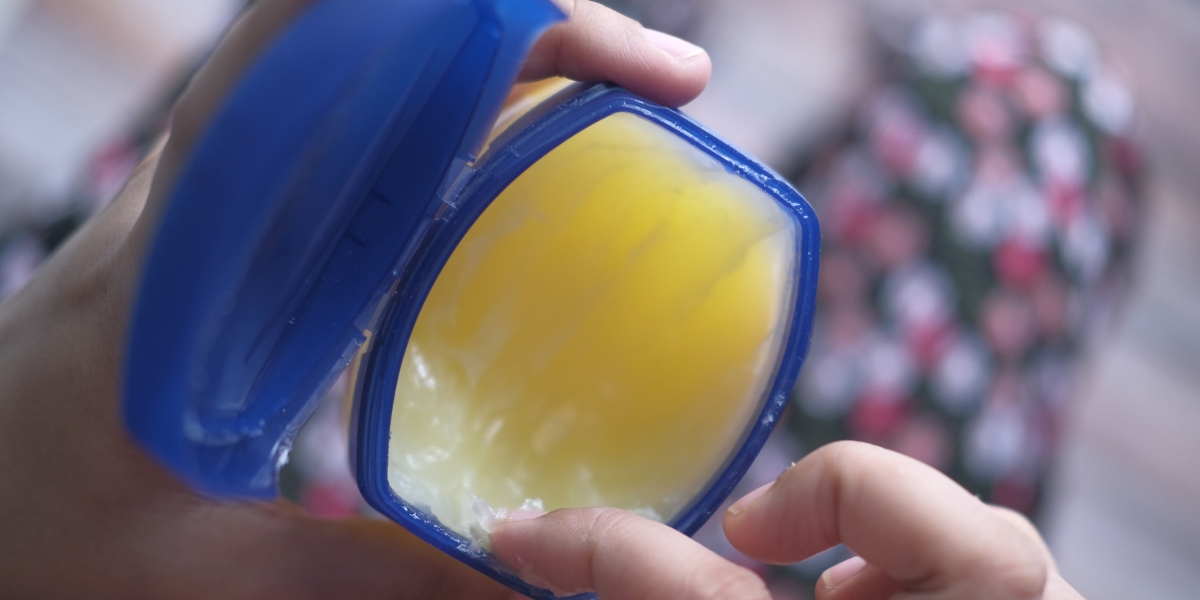Vaseline is a common household item often used to solve minor issues like cracks or chips off the skin. While it’s generally safe to use on dogs, using too much can lead to stomach upset if your dog ingests it. This blog will explore its suitability, emphasizing the importance of professional advice when considering this effective remedy.
Understanding Vaseline and Its Common Uses
Vaseline, also called petroleum jelly, is a semisolid, jelly-like substance made from a mix of mineral oils and waxes. Known for its ability to lock moisture in, this product is widely used by humans to manage skin conditions like dry skin, minor cuts, and burns.
It forms a barrier that helps protect the skin and prevent moisture loss, offering relief and promoting healing. While it’s a go-to for people, it’s essential to consider its safety before applying it to your dog’s sensitive skin.
Is Vaseline safe for my dog?
Vaseline is a staple in many medicine cabinets, commonly used to treat cuts, burns, and dry skin in humans. While it is generally considered safe for topical use on dogs, it can lead to stomach upset if your dog licks off too much. This can result in gastrointestinal problems, such as vomiting and diarrhea, so it’s important to be cautious.
Vaseline is often used to protect dogs’ paws or cracked noses, especially during cold weather. It helps heal superficial wounds by creating a moisture-sealing barrier that traps dirt, bacteria, and unwanted toxins, protecting the dry skin. However, it’s important to keep it in check as it can be harmful if ingested in excess.
For more specialized care, consider using balms that are specifically formulated for dogs. These can be a better alternative for protecting your pup’s paws or nose without the risks associated with petroleum-based products. If you’re concerned, it’s always a good idea to consult a vet to rule out any potential medical conditions that might require a different approach.
Potential Risks of Using Vaseline on Dogs
When using Vaseline on your dog, it’s crucial to understand the risks involved to avoid potential health complications for your beloved pet.
Skin Complications: Vaseline acts as a barrier agent, helping to protect a dog’s skin by trapping bacteria and debris. This can prevent infections and stop the condition from worsening.
However, it can also be potentially harmful in some cases, leading to further complications or irritation, especially if used on existing conditions.
Ingestion Issues: If a dog licks and ingests Vaseline, it can lead to gastrointestinal blockages, upset stomach, and even be toxic. Vaseline is meant for external use on humans, not dogs, and can interfere with digestion and nutrient absorption.
While it’s a handy product for humans, it’s not recommended for dogs due to the potential risks of ingestion that can affect your pet’s health and comfort. It’s best to use products specifically formulated for dogs.
Causes of Dry, Itchy Skin in Dogs
Dry, itchy skin or pruritus in dogs is a common concern for owners and can lead to severe itching with signs like redness, pustules, sores, scabs, odor, and hair loss. It’s important to consult a vet to determine the underlying cause and explore treatment options, as this condition can be frustrating to manage without proper care.
Common causes of dryness and cracking on a dog’s nose or paw pads include allergies, poor diet, environmental factors, fleas, external parasites, skin infections, or systemic diseases like hypothyroidism. Using Vaseline without proper guidance might make these conditions worse. According to Dr. Liza Cahn, it’s crucial to address the root cause with the help of a vet to ensure effective treatment.
What to do if your pup eats Vaseline?
If your pup accidentally eats a little bit of Vaseline, don’t panic—it’s usually harmless. However, if your dog has managed to eat a lot, it’s essential to watch for signs like an upset stomach or vomiting.
In such cases, contact your veterinarian immediately. Since a dog isn’t supposed to ingest this substance, a vet’s advice can help ensure your pup stays safe and healthy.
Tips for using Vaseline on your dog’s cracked and dry paws
Use Vaseline with caution, as petroleum jelly can be messy and your pup may be tempted to lick it off. Here are some tips for applying it to your dog’s paws.
Use only a thin layer of Vaseline – A little Vaseline goes a long way when applying it to your dog’s paw pads; this helps avoid globbing and keeps your pup from tracking it through the house.
Try applying Vaseline outside — To keep your pup from tracking Vaseline on the floors, try applying it outside or near the door. In nasty weather, you can stay inside but make sure to go for a walk immediately after use.
Wipe off Vaseline after the walk — When your pup comes in from the elements, wipe off any leftover Vaseline from their paws. This is especially helpful in winter to remove ice, snow, salt, and de-icing chemicals after a walk.
Use booties — A great way to stave off the mess is to let your dog wear booties instead of applying Vaseline or petroleum jelly. If you do apply it, let it dry and remove excess from their paws. Booties can shield their feet, protect against cuts and blisters, and help ensure the skin heals properly.
Paw-protecting alternatives to Vaseline
Instead of Vaseline, it’s better to use specially formulated balms for dogs. These products soothe dry, cracked skin and protect paws and noses without risking your pup ingesting too much, which could cause tummy issues. For big lickers like my dog Dudley, balms labeled safe for canine use are a must to hydrate and protect sensitive areas safely.
Safer Alternatives to Vaseline for Dogs
While Vaseline can seem like a good option to moisturize your dog’s dry skin or protect cracked and itchy areas, it’s not always the best choice. Products specifically formulated for pets are safer, as they use ingredients that are safe even if ingested in small amounts. These alternatives can help protect paws, ears, and other sensitive areas more effectively.
If your dog’s skin issues persist, consider asking a vet for advice. They may recommend a medicated shampoo to treat the cause of your pup’s skin issue and provide lasting relief. With so many products on the market, you can find safer options to keep your dog’s skin healthy and comfortable.
Coconut Oil: Pet parents often turn to coconut oil or olive oil as a natural moisturizer for their dog’s skin. Vets may also recommend adding an omega-3 fatty acid supplement like Nordic Naturals Omega-3 Pet to soothe dry skin. These oils are a mess-free, effective treatment for dry noses or skin, and can be safely applied in a small amount for easy absorption.
Shea Butter: A natural option to add moisture is unscented, pure shea butter, which is safe for pets.
Humidifier: In a dry environment, using a humidifier can help keep your dog’s skin and nose hydrated. Learn more about what causes changes in your dog’s nose color.
Regular Hydration: Ensure your dog is drinking enough water, as dehydration can contribute to dryness in their skin.
Note: If your dog has itchy skin, it could be due to an underlying allergy or infection, where medicated shampoos or prescription medications may be required. In addition, consult a vet to address the result of the allergy or infection effectively.
When to Consult Your Veterinarian
If your dog has skin issues like dry or cracked paws, it’s important to consider safer alternatives. Many products on the market are specifically formulated for pets and are designed to help with protection and healing.
Unlike regular Vaseline, these contain ingredients that are safe if ingested in small amounts. Always consult your veterinarian for the best option to keep your dog’s skin healthy and cared for.
You may also find these health-related articles helpful:
Dog Ate Weed? Symptoms & What to Do Next
Why Is My Dog Acting Drunk & Wobbly?
Chocolate Poisoning in Dogs: What to Do Immediately









